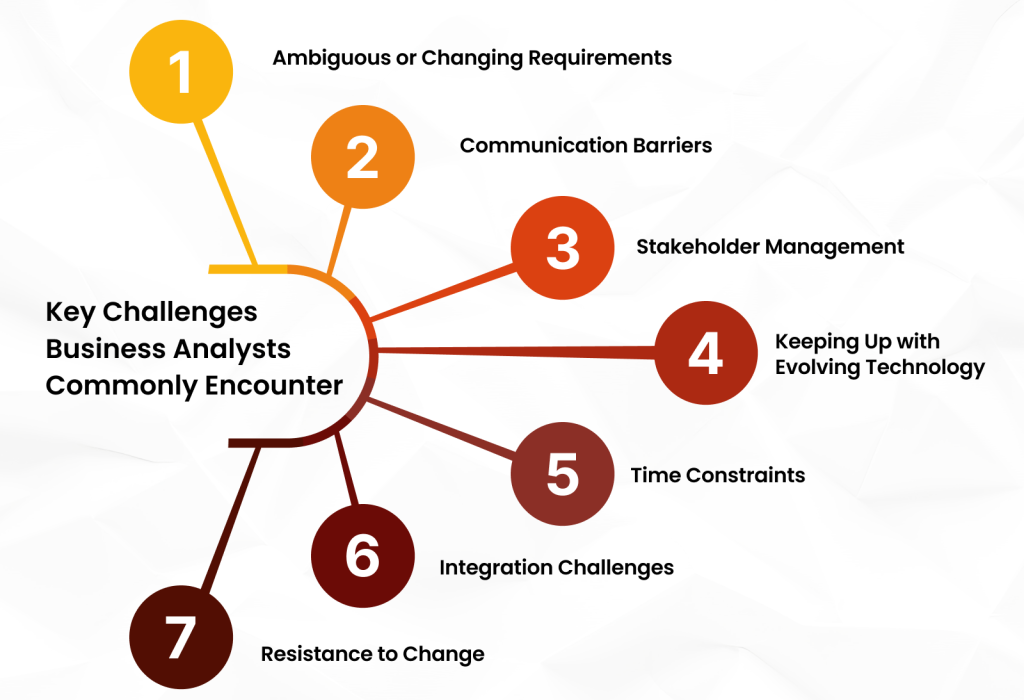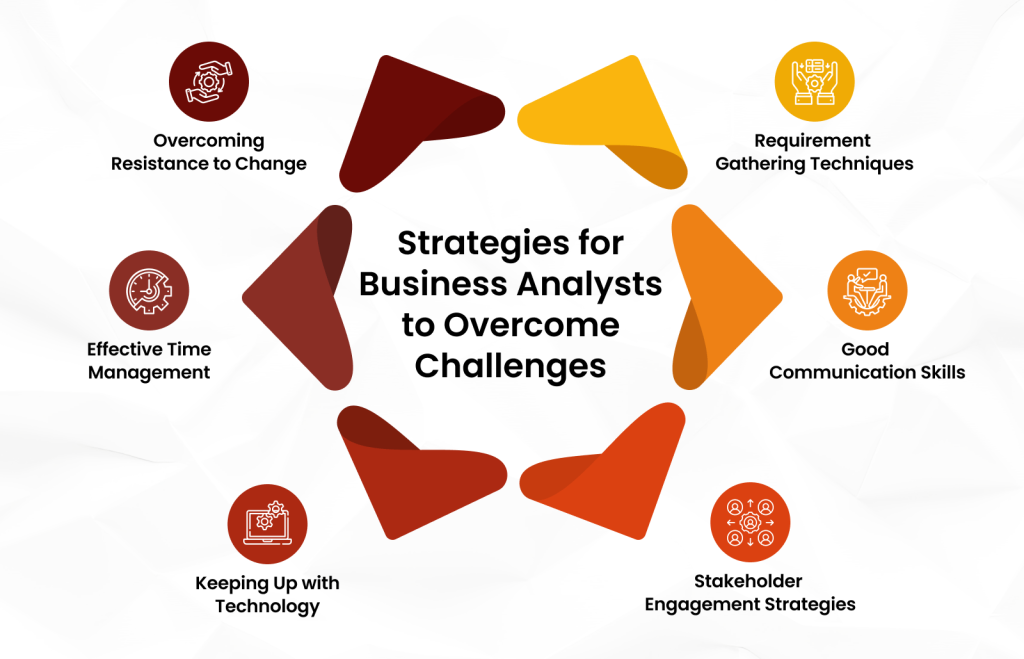The role of a Business Analyst (BA) has become indispensable. Tasked with bridging the gap between stakeholders and technical teams, BAs play a pivotal role in ensuring that business objectives align seamlessly with technological solutions. By acting as a communication conduit, they translate intricate business needs into actionable insights, driving efficiency and innovation.
However, the role of a Business Analyst is not without its hurdles. From managing diverse stakeholder expectations to keeping up with rapidly evolving technologies, business analyst challenges are as dynamic as the industries they serve.
In this article, we will explore the everyday challenges of business analytics, discuss practical business analysis solutions, and explain how organizations can overcome these obstacles to achieve sustained success.
Whether you’re an experienced BA or an aspiring professional, understanding these challenges is key to tackling the complexities of modern business and harnessing the full potential of analytics-driven decision-making.
Top Challenges Faced by Business Analysts
Business Analysts (BAs) play a crucial role in ensuring that organizations meet their objectives through the effective use of data and technology. However, as with any strategic position, BAs encounter business analyst challenges that can make their work complex and multifaceted.
Business analyst challenges can take many forms, from vague requirements and communication issues to technological advancements and resistance to change. Recognizing and understanding these challenges is key to finding business analysis solutions that facilitate better decision-making, enhance collaboration, and ultimately lead to successful project outcomes.
By staying adaptable, continually learning, and fostering clear communication, Business Analysts can overcome these obstacles and add significant value to their organizations.
Let’s dive deeper into the top challenges BAs face today and how understanding these hurdles can help overcome them with proper business analysis solutions.

1. Ambiguous or Changing Requirements
One of the most prominent business analyst challenges is dealing with ambiguous or frequently changing requirements. Stakeholders may often have unclear ideas about the project’s objectives or fail to communicate their needs accurately. This uncertainty can lead to misalignment between the business’s vision and the final solution, wasting resources and time.
Additionally, requirements can evolve throughout the project’s lifecycle as stakeholders’ needs or market conditions shift. These constant changes can create frustration, delays, and confusion for the business analyst, who must continuously adapt and recalibrate strategies.
To manage this, BAs should collaborate closely with stakeholders to clarify goals and document every change meticulously, ensuring alignment between evolving requirements and project deliverables.
2. Communication Barriers
Communication is at the heart of the BA role, but it isn’t always as straightforward as it seems. Business Analysts must communicate effectively with technical teams and non-technical stakeholders, each of whom may have its language, priorities, and expectations.
Misunderstandings can occur if BAs fail to tailor their communication style for different audiences. The complexity of business analytics challenges also stems from the need to bridge the gap between technical jargon and business language.
An analyst may find it challenging to convey technical specifications in terms that business stakeholders can understand or vice versa. Business analysis solutions to this challenge include using visual aids like diagrams and flowcharts and holding regular alignment meetings to ensure everyone is on the same page.
3. Stakeholder Management
Managing diverse stakeholder expectations is another significant challenge for BAs. Stakeholders often have differing objectives, priorities, and timelines, creating tension when reconciling all interests into a single plan. A Business Analyst must skillfully navigate these conflicts to align the project with the organization’s goals.
Furthermore, stakeholders may have competing interests, and BAs must balance satisfying those demands without compromising the project’s integrity. Effective business analysis solutions for stakeholder management include setting clear expectations upfront, creating transparent communication channels, and ensuring stakeholders are engaged throughout the project to address concerns proactively.
4. Keeping Up with Evolving Technology
As technology evolves rapidly, Business Analysts must stay updated with the latest tools, techniques, and software. This constant shift in technological landscapes makes it challenging to identify the best solutions to meet business needs, as outdated or inefficient technologies can hinder a BA’s ability to deliver results.
To combat this, BAs must adopt a mindset of continuous learning technology-related business analytics challenges, regularly attend training sessions, webinars, and conferences, and collaborate with IT teams to stay informed about new tools and methodologies.
Overcoming business analytics challenges related to technology requires a proactive approach, which includes conducting regular technology assessments to determine whether current solutions are still meeting business needs or if new, more effective options should be explored.
5. Time Constraints
Business Analysts often work under tight deadlines, which can add stress and pressure to their already demanding roles. The need to quickly gather requirements, analyze data, and implement solutions within a short time frame can lead to poor-quality outputs or overlooked details. Additionally, with many projects running concurrently, BAs may struggle to prioritize tasks effectively.
Time management is essential to overcoming this challenge. BAs can break down tasks into manageable chunks to manage time efficiently, focus on critical deliverables first, and communicate realistic timelines to stakeholders. Leveraging tools like project management software and adopting agile methodologies can help BAs stay organized and meet deadlines without compromising quality.
6. Integration Challenges
In today’s complex business environment, companies often rely on multiple software systems and technologies that must work together seamlessly. Integration challenges arise when different systems, databases, or software solutions are incompatible or difficult to integrate.
These challenges can hinder a BA’s ability to propose practical solutions that meet business needs across various departments. BAs must collaborate with IT teams to ensure new solutions integrate smoothly with existing systems.
Analyzing the compatibility of different systems early on in the project and choosing flexible, scalable technologies can mitigate these integration challenges. Business analysis solutions to integration problems include conducting thorough assessments of the organization’s tech stack and designing scalable architectures for smooth integration.
7. Resistance to Change
Lastly, BAs frequently face resistance to change when implementing new processes, technologies, or strategies. Employees or stakeholders may be apprehensive about the changes a new system or project introduces, fearing disruptions to their daily work or the learning curve associated with new tools.
To overcome this resistance, Business Analysts must champion change, guiding stakeholders through the process with clear communication and training. By illustrating the new solution’s benefits and involving employees in the implementation process, BAs can help create a sense of ownership and reduce resistance. Offering continuous support and addressing concerns as they arise will make the transition smoother.
How Business Analysts Can Overcome These Challenges?
While business analyst challenges can seem daunting, they are not insurmountable. Business Analysts (BAs) can navigate these hurdles and ensure successful project outcomes by employing effective strategies and tools. While business analyst challenges are an inevitable part of the role, the right strategy can significantly ease the burden.
BAs adopting these business analysis solutions can mitigate common roadblocks and deliver successful outcomes through effective requirement gathering, improved communication, or technological change management.
Below, we explore how BAs can tackle these challenges through targeted approaches backed by real-time statistics where applicable. These solutions not only help overcome challenges but also enhance the value BAs bring to their organizations.

1. Effective Requirement Gathering Techniques
One of the most significant business analyst challenges is ambiguous or frequently changing requirements. To address this, BAs must employ effective requirement-gathering techniques. One such method is the Use Case Approach, which helps identify all potential user interactions and define clear outcomes.
Additionally, Interviews and Workshops with key stakeholders allow BAs to collect rich, qualitative data that can clarify vague requirements. A Project Management Institute (PMI) study reveals that approximately 37% of projects fail due to a lack of precise requirements.
This statistic emphasizes the need for BAs to invest time in comprehensive requirement gathering to ensure alignment between business objectives and technical solutions. Techniques like prototyping and storytelling can also help stakeholders visualize the end product, reduce misunderstandings, and align expectations.
By implementing these techniques, BAs ensure a clearer understanding of the project scope, preventing costly changes and delays that arise from unclear or miscommunicated requirements.
2. Improved Communication Skills
Effective communication is at the heart of a BA’s role, but bridging the gap between technical teams and business stakeholders is not always easy. One key to overcoming business analyst challenges related to communication is improving communication skills.
BAs should be adept at translating technical jargon into business terms that stakeholders can understand and vice versa. Tools like Data Visualization (charts, graphs, dashboards) and Business Process Modeling (BPMN) can enhance clarity by simplifying complex data and processes.
For example, clear communication can help prevent misunderstandings regarding project requirements and expectations, thus ensuring smoother execution and timely delivery.
BAs should also develop active listening skills to understand the concerns and needs of both business and technical teams. Regular status update meetings, where all parties discuss progress, challenges, and concerns, are effective ways to maintain clear communication.
3. Stakeholder Engagement Strategies
Another critical business analyst challenge is managing stakeholder expectations. Successful stakeholder engagement ensures all parties are aligned and committed to the project’s success. One strategy to overcome this challenge is establishing a Stakeholder Map, which helps BAs identify key stakeholders’ interests, influence, and communication preferences.
This map allows BAs to tailor their approach to each stakeholder’s needs and ensures relevant and timely communication. Moreover, Regular Check-ins and Feedback Loops are essential. Research shows that projects with continuous stakeholder engagement are 78% more likely to be successful than those without.
BAs should leverage collaborative platforms like Slack or Microsoft Teams for real-time updates and discussions, ensuring stakeholders remain involved and invested throughout the project lifecycle. Another important strategy is setting clear expectations early on. This includes defining roles, responsibilities, and communication channels, which helps mitigate confusion or conflicts.
4. Staying Technologically Updated
As technology evolves rapidly, staying updated is essential for BAs to remain competitive and relevant. Overcoming business analytics challenges related to changing technologies requires continuous learning. However, this challenge can be mitigated by regularly attending industry webinars, conferences, and workshops.
BAs can also collaborate closely with IT teams to keep abreast of the latest trends in data analytics, machine learning, cloud computing, and other relevant technologies. By gaining hands-on experience with tools like Power BI, Tableau, or Google Analytics, and leveraging insights from data analytics consulting, BAs can improve their ability to suggest more effective business analysis solutions.
Adopting Agile Methodologies can also allow BAs to respond more effectively to technological changes. Agile encourages iterative development, allowing BAs to continuously test, refine, and improve processes based on emerging technologies.
5. Time Management Tips
Time constraints are one of the top business analyst challenges, as BAs often work under tight deadlines. To manage time effectively, BAs can organize their tasks using techniques like time blocking and prioritization matrices. They can address this by focusing on high-impact tasks that contribute directly to project success, such as gathering key requirements, testing solutions, and managing stakeholder expectations.
Tools like Trello, Asana, or Monday.com can help BAs track progress and deadlines, allowing them to delegate and stay organized. BAs should also focus on eliminating distractions by creating precise work schedules, setting realistic timelines, and breaking large projects into smaller, manageable chunks.
Another business analysis solution is adopting the Pomodoro Technique. This technique encourages short, focused work intervals followed by brief breaks. It can help maintain high productivity levels throughout the project lifecycle.
6. Addressing Resistance to Change
One of the most challenging aspects of business analysis is overcoming resistance to change. Employees or stakeholders may be hesitant to adopt new technologies or processes, fearing disruptions to their workflow or the uncertainty of learning new systems. BAs can address this challenge by positioning themselves as change advocates and guiding stakeholders through the transition process.
According to research from Prosci, 74% of change initiatives fail due to a lack of employee buy-in. To overcome this, BAs should involve employees in the change process early on, highlighting the benefits of new systems and giving them a sense of ownership. Training and upskilling programs are also crucial in ensuring the smooth adoption of new technologies.
BAs can use Change Management Models, such as Kotter’s 8-Step Change Model, to systematically guide organizations through transitions. Regular communication and real-time support can also alleviate concerns and build confidence in the new processes. Additionally, addressing stakeholder concerns and providing feedback loops can help mitigate any fears associated with change.
Conclusion
Business Analysts (BAs) play a vital role in overcoming challenges such as unclear requirements, communication gaps, and evolving technologies. They can drive successful project outcomes by leveraging effective solutions such as clear requirement gathering, improved communication, and staying updated with technology.
To address these challenges, partnering with experts like Folio3 Cloud and Data can provide the necessary tools and strategies, helping businesses optimize data analytics, streamline cloud migrations, and navigate the complexities of modern business environments.



